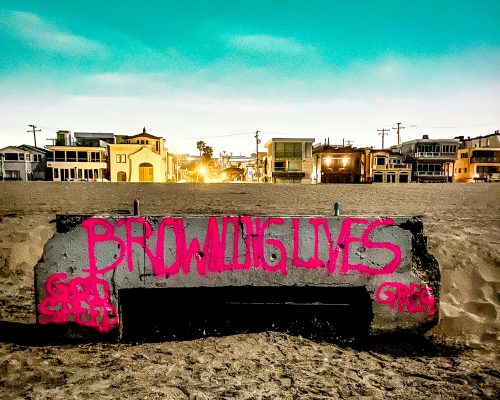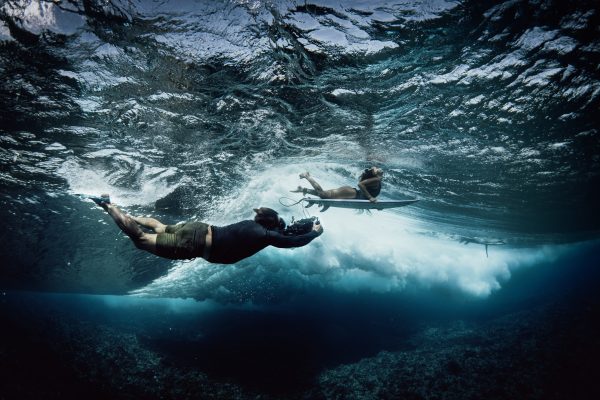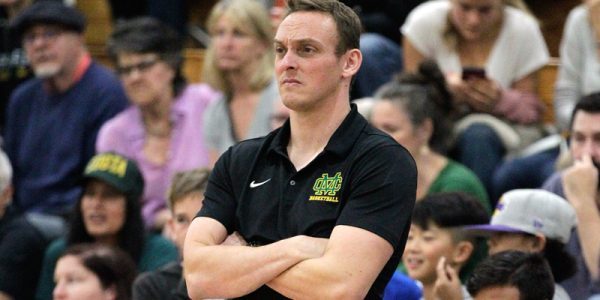by Kevin Cody
Dave Hollander’s first surf job was at the Bing Surfboard factory on Surfboard Row (Cypress Avenue) in Hermosa Beach. The striking pinstriping work on the garage boards the 15-year-old had made had landed him the job. His mom, Joanne, dropped him off.
When his mom picked him up at the end of the day he told her, “Someday, I’m going to own that place.”
Twelve years later, Hollander called his mom and asked, “Do you remember what I told you after my first day at work?”
“A mother never forgets those things,” his mother answered.
He told her, “Phil, and Steve, and I just signed a lease.’”
Phil was shaper Phil Becker. Steve was glasser Steve Mangiagli. The lease was for a former laundromat on Pier Avenue in downtown Hermosa, where in 1980 the three would open the first Becker Surf Shop.

Hollander recalled the story in 2009 when he was presented with the Lifetime Achievement Award at the Bank of Manhattan Entrepreneur Awards Dinner. The following year, industry conglomerate Billabong would buy Becker Surf (though not the affiliated Mangiagli Glassing) for an undisclosed amount.
By then, Hollander had become one of surfing’s most respected business leaders. He managed seven Southern California Becker Surf stores, and 170 employees. BeckerSurf.com was second in sales only to Pacific Sunwear, a billion dollar company with 800 retail stores. In 2000, “Transworld Surf” named Hollander one of the surf industry’s seven most influential people. (The others were Quiksilver president Bob McKnight, Pacific Sunwear president Tim Harmon, Volcom president Richard Woolcott, Billabong USA president Paul Naude, and Surf Board Retailers Association Director Roy Turner.)
“Dave would tell you he wasn’t a gifted athlete. But he knew how to get priority. So he always got more waves than anyone else. He was the same in business. Dave could see what was coming before everyone else,” Hollander’s longtime friend, and Becker Surf attorney Kent Burton said this week.

Hollander recalled working on the board in an email to Easy Reader in 2021: The board is faded after 50 years, as all the colors except the black pin lines are resin tints. There was a beautiful blue tint, which has yellowed, and shows now as a dark green. The light, yellowy orange was a more vibrant orange, and the light pink was a wonderful, transparent red (red always fades the most)…. It took me about three months, working a bit each day after work in the factory. Never thought much of it (okay, really looked forward to working on it each day) until it was finished, when I and others started saying “Wow.” Photo courtesy of the Hollander family
Hollander passed away Friday, November 3, at his home in Palm Springs, after a decade-long fight with cancer. He was 72.
In addition to uncanny foresight, the tall, blond Hollander also benefited from his affable personality, Burton said.
“When asked by restaurant hosts if we had reservations, Dave would answer, ‘Absolutely none. We’re looking forward to dining here.’”
During his last weeks, when a doctor asked to take his vitals, Hollander responded, ‘Will I get them back?’”
Burton, whose office was a few doors up the street from Becker Surf’s Pier Avenue shop, met Hollander in 1993, after sending him a cease and desist letter. Burton’s client was a rival surf shop that claimed exclusive sales rights to a board brand Becker had advertised.
“Dave called and asked the legal basis for my argument. I admitted I didn’t really have one. Then he said, he didn’t really want to sell the disputed boards, anyway. And by the way, did I play volleyball? We played every weekend at 24th Street for the next 15 years, until Dave moved to the desert.”
“Phil, Steve and Dave were a perfect team,” recalled longtime Becker Surf employee Fred Williams. “If you asked Phil how the future looks, he’d say, ‘I don’t know. We might be out of business tomorrow.’ Ask Steve and he’d tell you the way it was. Ask Dave, and he’d say, ‘We’re going to conquer the world.’”
“All three were workhorses. Phil would arrive at the factory at 7 a.m. and not leave ‘til 7 p.m. And Steve arrived ahead of Phil. Dave would have sold his house to save the business,” Williams said.
“We each put up $8,000, and agreed if there was a dispute it would be resolved by majority vote,” Hollander told Easy Reader in a 2004 interview. “Over the next 30 years, we had two votes. Phil lost both of them. One was about the name.
“‘Davey, do you know how weird it is to see your name on people’s T-shirts,’ Phil once told me. At the time we were selling 10,000 Becker T-shirts a year,” Hollander said.
“The other dispute was about whether or not to buy a new shop van. Phil didn’t think we needed one,” Hollander said. “He was so frugal, he wouldn’t flip you for a nickel, and paid cash for everything.”
Becker shaped. Mangliagi glassed. Hollander, after a year of pinstriping, and managing the store, trained Jose Barahona to do his factory work, and focused on the store. (Barahona today is one of Surfboard Row’s most respected shapers.)
Hollander understood the importance of “protecting the core” before the phrase was invented. He staffed Becker’s seven stores with surf-stoked salespeople for whom work was as much a lifestyle as a livelihood. The three partners steadfastly resisted pleas from shopping center developers to franchise the Becker name.
“I realized long ago,” Hollander said in the 2004 Easy Reader interview, “that if Becker got too big, we’d lose what we’re all about, which is a family of employees and customers with a little factory that makes surfboards. People want that sort of authenticity and it’s harder and harder to find anymore.”
To retain good people, Hollander established a generous bonus program and hosted employee surf trips.
To give his stores a signature look that was neither too slick, nor too shoddy, Hollander enlisted 16-year-old Brian Bent. The self-taught folk artist hung paintings and assemblages in the stores for over two decades, while establishing himself as a preeminent surf artist.
Hollander’s anticipation of trends was so widely recognized that surf apparel companies would monitor Becker Surf sales before settling on the following season’s lines.
Mangiagli recalled how Hollander resolved the nagging surf shop problem of apparel reps fighting over floor space.
“Dave convened a meeting of the reps and told them they’d each get assigned floor space. And the more they sold, the more floor space they’d get. It made the reps work really hard,” Mangiagli said.
When “Blue Crush” came out in 2002, Mangiagli recalled, Hollander created a women’s section in their stores, with boards Becker shaped for women. Sales boomed.
Hollander was equally adept at responding to the industry’s frequent downturns.

In the late ‘90s, when surfboard sales stalled because the thin “potato chip” boards popularized by pro surfers made surfing difficult for beginners, Becker Surf partnered with Easy Reader and Chevron El Segundo to start the Chevron Surf Camp. An average of 400 kids learned to surf at the camp every summer over the ensuing three decades. (In recent years the camp has been directed by coach Vince Ray, and administered by the City of Hermosa Beach.)
Mangialgi noted that Becker Surf’s best selling board was the LC-3 (Lance Carson 3-fin), an easy to ride mid-length board.
“The LC-3 was the Wavestorm of its day,” Mangiagli said. (The soft top Wavestorm today is the world’s best selling surfboard because, like the LC-3, it is easy to ride.)
Even more challenging to the surf industry than the cyclical economic downturns was the 2005 closure of Clark Foam, due to State environmental regulations. Surfer magazine underscored the magnitude of the crisis with a headline that asked, “Is this the end of the custom surfboard?”
Clark Foam supplied an estimated 80 to 90 percent of the foam blanks used in the manufacturing of surfboards, worldwide. Becker’s factory shaped and glassed 5,000 boards annually, all with Clark Foam blanks.
Hollander, in a letter to employees, penned at 4 a.m. the morning after Clark’s closure, wrote, “You do the math. There are no other blanks available in the world.”
Then he laid out an audacious plan.
“We are Becker Surfboards. We need Becker Surfboards in our stores to be who we are. As it will take six months, easy, to either ramp up new production, or find another source for our boards, we have to make those 800 we have last for six months.”
Apparel, and accessories account for most of surf store revenues. But surfboards are the bellringers that bring customers in the door.
Fortunately, by 2005 Becker was no longer dependent exclusively on store sales. A decade earlier, Hollander had foreseen the impact ecommerce would have on retail.
“On a foggy day, one of our retail stores might not have 40 visitors. But it’s never foggy in cyberspace. And if you live in New York and it’s winter, it’s hard to find a bikini for your trip to the Bahamas. But you can find one online,” Hollander said in the 2004 Easy Reader interview.
Hollander would also credit BeckerSurf.com with saving his company during the COVID pandemic retail closures.
Hollander learned the importance of apparel and accessories prior to co-founding Becker Surf, when he, Becker and Mangiagli were making boards for Rick Surf, and an Australian named Bob McKnight stopped by the Pacific Coast Highway shop with his car trunk filled with Quiksilver board shorts.
“Unbeknownst to us, surfing apparel was about to take off. O’Neil had just started allowing retailers to sell their wetsuits, and Michael Thompson was about to follow McKnight over from Australia with his Gotcha board shorts,” Hollander recalled. Until then, surf shops sold boards, wax, leashes, sandals, and not much else.
Two decades later, when Hollander was developing the Becker website, McKnight would again inspire Hollander, though this time inadvertently.
By then McKnight’s Quiksilver’s $1.3 billion in annual sales made it surfing’s largest apparel company. But McKnight was dismissive of ecommerce. In 2000, McKnight told the industry bible TransWorld Surf, “I don’t know if you remember this, but the SIMA (Surfing Industry Manufacturers Association) Surf Summit a few years ago was all about internet and internet sales, and I just went, ‘F… that! We need to look after the shops.’”
Outwardly, Becker Surf appeared similarly wedded to surfing’s Luddite culture. Phil Becker, like a modern day John Henry, refused to employ a shaping machine. He used three Rockwell planers, all bought in 1965, and periodically rebuilt, to shape an estimated 130,000 surfboards over his career.
“They’re great for doing 300 or 400 identical boards,” Becker said of shaping machines. “But they stifle creativity and I don’t like to compromise. Every surfer is different and every wave is different, so every board should be different,” he said in a 2005 Easy Reader interview.
During the four years preceding McKnight’s dismissal of ecommerce, Hollander had been quietly developing BeckerSurf.com. After hearing McKnight’s comment, it wasn’t hard for Hollander to convince McKnight to give him exclusive ecommerce rights to Quiksilver’s popular apparel.
Hollander’s decision to develop BeckerSurf.com was as much personal as business driven.
“I felt like I had been doing the same thing forever and the internet was like a new pool toy for me,” he said at the time.
“The surf industry, being as archaic as it is, is leery of the internet. And the people who do believe in the internet don’t know retail. Everyone is following the Amazon model, which says you can only sell easy to market stuff like books, videos, board bags and surf leashes.
“The popular wisdom was that fashions change too quickly for internet sites to keep up. But we’re use to that in retail. We have to predict fashions,” Hollander said.
Hollander even put bikinis online, despite knowing bikini buyers to be the world’s pickiest shoppers. During the 2004 Easy Reader interview he printed out a Beckersurf.com sales report that showed four bikini sales within the past hour and a half – all to Hermosa residents who lived within blocks of Becker’s flagship store.
“The pundits also said online stores had to use low bandwidth, dial-up lines because not enough people had DSL. But I knew Becker’s customers would want a quality site that only broadband can provide, and I knew our customers are affluent enough to have broadband in their homes.”
Mangiali said BeckerSurf.com had the advantage of seven stores that served as warehouses. A truck ran between the stores, and a 20,000 sq.ft. fulfillment center in Torrance.
Another advantage of Beckersurf.com, Hollander said, was it helped preserve his company’s core identity with surfers.
“Beckersurf.com allows us to sell all over the world without having to open so many new locations that we would be bastardizing the Becker mystique,” he said. “Our retail stores are our heart and soul and will be as long as Phil, Steve and myself are on this earth.”

Shortly before his death, Hollander recalled the Becker Surf years as surfing’s second “Golden Era.”
“Leading Becker retail and online was just nothing short of a fairytale,’ he said. “Businesswise, you could do no wrong. It was that hot. The people were genuine, passionate, and committed to the lifestyle and the sport. I can’t imagine anything like that ever happening again. It was just such a unique set of circumstances, passions, and characters colliding.”
“I believe it is over,” he said. “Circumstances changed, the characters got old and moved on. I do not believe those true passions will ever exist again.
Phil Becker passed away in 2021.
In September, knowing his end was near, Hollander couldn’t resist a final jibe at Mangiagli, the last surviving Becker Surf founder.
Hermosa Beach Historical Museum director Jamie Erickson had sent Hollander a photograph of a pinstriped knee board with a Rick laminate on its deck.
Erickson wanted to authenticate the board’s provenance, and asked if he had done the pinstriping.
Hollander replied, “I was not involved with this board. But since the Rick laminate is so crooked, I’m guessing Steve Mangiagli was.”
Dave Hollander is survived by his wife Barbara, former wife Sally, father Richard Roberts, sister Suzie Wright, children Hailey and Jory, and grandkids Sonny and Bowie.
Services have not yet been scheduled. ER








